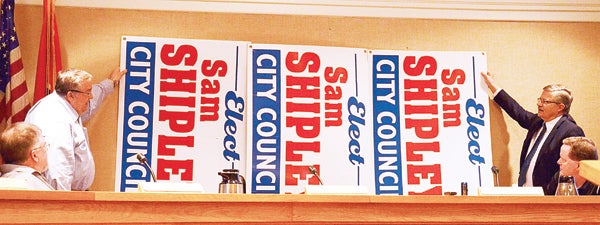Sign ordinance passes; downtown restroom project developing
Published 9:33 am Monday, March 14, 2016

Star Photo/Rebekah Price
Councilman Sam Shipley (right) used some of his old political signs to demonstrate the size of sign that the proposed sign ordinance would allow for in residential districts R1, R2 and R3. Shipley said this would be the size allowed for home businesses in neighorhoods and that he thought it was entirely too large. Councilman Jeff Treadway (left) helped hold the sign.
Businesses, organizations and event organizers may have to adjust to new sign regulations, but Planning Commissioners and City Councilmen are convinced the changes will help clarify residents’ rights and allowances with signs in Elizabethton.
City Councilmen unanimously approved a new sign regulation ordinance on second reading Thursday night, following almost eight months of meetings, discussions and draft adjustments.
The ordinance will replace Title 14, Chapter 5 Sign Regulations which has been a source of confusion for both Planning Commissioners and the city’s code enforcer.
Beginning Council discussion on the ordinance, Councilman Sam Shipley explained his concern for the 36 square foot and 48 square foot signs which would be allowed in certain residential districts. He displayed a similarly sized sign by attaching some of his old political signs together and making a roughly 36 square foot sign, which he and Councilman Jeff Treadway held before the Council.
Elizabethton Director of Planning and Economic Development Jon Hartman had previously explained to the Planning Commission that this was to allow for neighborhood signs.
Shipley said he did not have a problem with this, but that he did have concern about individual homeowners having a sign of that size in their yards advertising home businesses or services. Shipley recommended residential signs be limited to six square feet. The proposal passed with this amendment.
Tiffany Gold, owner of Primp’N’Tease Hair Salon in Elizabethton, asked the Council how this would be enforced. She said that in the past, her temporary signs had been removed by the code enforcer and disposed of improperly. This cost the city $200 to replace, she said, questioning whether large businesses and small businesses would be held to the same standards of enforcement.
She also asked why the city would be exempt from the ordinance, where it was not exempt from previous regulations.
Hartman said they assume that the [city] administration would use due diligence and common sense when implementing or constructing a new sign in an area where these types of signs may not be appropriate.
“I think the main concern here is that cities oftentimes will have facilities or locations in areas that businesses are not allowed in,” Hartman explained. “The Recreation Center is a perfect example; it’s in the middle of a residential neighborhood.”
Hartman explained in January that the primary differences of the new ordinance are the allowance of permitted temporary and off-premise signs, clarification of the appeals process, and a change in regulations for signs in a site distance triangle at an intersection allowing signs under 18 inches or taller than eight feet.
Hartman said the application process will be the same for permanent signs, but that a database will be created for temporary sign permit holders.
Temporary sign permit holders will be required to keep a copy of sign permits on premises, Hartman said. Temporary signs will allowed to be displayed for 90 days, and then taken down for 30, but during interim periods, another type of permitted temporary sign may be displayed. Temporary banners, wall signs, freestanding, and vertical flag signs will require permits from City Hall. Political, real estate and lawn signs do not require permits, but they are regulated with certain restrictions regarding timing and setbacks.
Temporary sign permit application fees are $10, and all other permitted signs have a minimum application fee of $75, according to the ordinance.
In other news, Councilmen considered a request by members of the Carter County Car Club for a public restroom downtown. The club has developed architectural drawings for a restroom located at the corner of East F Street and Armed Forces Drive at an estimated cost of $87,000 with Turnkey Construction.
The Car Club has pledges of material and labor donations valued at approximately $52,000, and requested $35,000 from the city.
Councilmen unanimously approved the project on first reading and approved commitment of $40,000 to the project, noting the benefit it offers visitors and residents downtown and on the Tweetsie Trail.
Because the location is in a parking area, and parking has been of continuing concern downtown, Mayor Curt Alexander asked if a different location would be possible. He suggested locating it within an unoccupied building downtown.
Elizabethton Director of Engineering Johann Coetzee said this might require the installation of a pump which could cost between $2,000 and $3,000. Coetzee asserted that the proposed location was the most cost effective place to build it.




